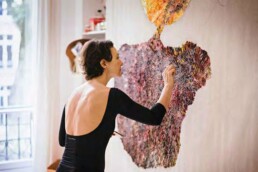YASMIN SMITH
On show at the Centre Pompidou exhibition « Cosmopolis #2: rethinking the human » (23.10.2019 – 23.12.2019), Yasmin Smith’s ceramics installation, Seine River Basin, is the result of three months of research into the hydrological and ecological systems of Paris’ River Seine and its tributaries.
Originally from Sydney, where her studio is still based today, her site-specific work lies at the intersection between art, archaeology and science.
Installation view Yasmin Smith, Seine River Basin, 2019, in Cosmopolis #2, Centre Pompidou, Paris (photo: Elle Fredericksen)
WHAT INSPIRED THE WORK THAT YOU EXHIBITED AT THE CENTRE POMPIDOU FOR "COSMOPOLIS #2"?
The inspiration behind this work was looking at the way river systems, plant ecology and humans all interact in an interconnected system.
In the year before coming to Paris, I produced a work in Tasmania using wood ash and forms derived from a flooded forest, as well as a work for the 2018 Sydney Biennale using wood from the Parramatta river, Sydney’s main river system. When I had the opportunity to come to France, I wanted to draw correlations between these environments on the opposite sides of the world.
Yasmin Smith: Drowned River Valley, 2018, 21st Biennale of Sydney (photo: Elle Fredericksen)
Yasmin Smith, Drowned River Valley, 2018, installation detail in Wood Drying Room showing branches: midfired slip with Parramatta River Mangrove wood-ash glaze (photo: Elle Fredericksen)
Yasmin Smith, Drowned River Valley, 2016-2018, 21st Biennale of Sydney (photo: Alex Kiers/The Commercial)
How would you like the work to be received the audience ?
When I present work I like to keep it quite minimal because I want the audience to notice the detail in the glazes that are made from the ashes of the original wood. Often when an audience sees my work they think it’s wood. Then they get closer and realise that it’s a completely different material and they’re inspired to understand more about it.
Yasmin Smith, Seine River Basin, 2019, Marne Willow (flotté) glaze detail (photo: Elle Fredericksen)
Why did you choose this particular hanging for the Centre Pompidou?
The feeling that I wanted to invoke when people saw it was as if they are looking at trees and their reflections on a body of water. It also forms a kind of spine, and many people have told me that they feel really calm when they look at it, which is nice to hear.
Is there a particular message you are trying to communicate?
What I’m presenting is a visual representation of the conditions of the soil and the water at a particular site – its natural geochemistry. Since trees grow and feed from the soil and water, they can therefore carry a message of their lifetime through the colour in the glazes I produce.
I also do a lot of research into the human activities that have occurred at the site that might have had an effect on the narrative held within the trees that grow there. I see my work as a transformation of the chemical information that’s already there in the environment into something that’s visually accessible to people.
Yasmin Smith (centre) with workshop students as part of her 2019 Centre Pompidou exhibition (photo: Elle Fredericksen)
Do you have an affinity with the term ‘environmental art’?
Environmental art already comes with a history and a particular movement and moment in time and I never really thought of myself in that category, although I can see how I fit aesthetically. I see my work as art that uses environmental science processes, so for me it’s a combination of these two things.
How do you feel your work has evolved through your artistic journey?
The first time I made a wood ash glaze, in central Australia, everything shifted for me. I suddenly saw the potential in this material, specifically the potential for it to be able to tell an important narrative of the Earth, of human beings and of their place within this whole ecosystem.
Secondly, I could see the potential for the process to go from one place to another. It’s something that I can do in any location and in each place it’s captivating because there’s a new story to be told.









